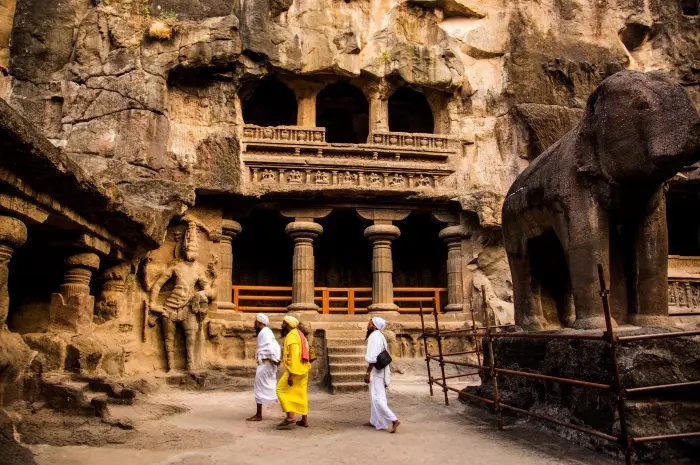A Chain Of Rock-cut Masterpieces
Ajanta Ellora Heritage Caves – You see a mountain and yet you take it easy. Others who don’t, think of climbing it. It’s not often that somebody thinks of cutting huge rocks and carves a chain of masterpieces out of it.
Well. Somebody, and when we saw it, we were awe struck by the selflessness of the hard work put in by those unknown artistes.
Ajanta has approximately 30 caves whereas Ellora has 34 caves carved out of rock admired by the tourists from all over the world.
The Chaitya halls and facades have vivid embellishments and carved work. Ajanta provides all the details about the development of Buddhist architecture in India.
Ajanta Caves and Ellora Caves India – Ellora Caves Travel are there in the Charanadari Hills in Deccan and are basically a series of Buddhist, Hindu and Jain shrines.
Ellora caves have 34 caves altogether out of which 17 are Hindu Temples, 12 are Buddhist and rest are Jain Temples Ajanta Ellora Caves India.
The Chaityas and Viharas of Ellora caves are sculpturally different from Ajanta as they are somewhat simpler and more primitive compared to Ajanta Ellora Caves India.
Located The Ancient Carvings
Ajanta caves are located at a distance of 101 km from the city of Aurangabad. It is situated near Aurangabad in Maharashtra. Ellora caves are located at about 30 km from Aurangabad Ajanta Ellora Caves India.
Ajanta Caves – From Oblivion To Fame
The Ajanta group of caves were unknown to the outside world for nearly a millennium, actually more than that.
It was discovered accidentally in the 19th century by a British Army Officer, John Smith while he was on a hunting expedition.
However, allow us to make one thing clear here, the Ellora caves were never out of public eye because it was situated on a busy route.
The Caves of Ajanta – Tell A Story
Caves of Ajanta – Its basically a narration of the story of Buddhism and its development. The tools used in this narration were simple things like hammer and chisel.
Some caves portray stories from Jatakas, which deal with the stories of various incarnations of Buddha Caves of Ajanta.
However, Ellora structures depict images related to three religions – Buddhism, Hinduism and Jainism.
Purpose Behind the Caves
The purpose behind building these caves was to provide the Buddhist Monks with secluded retreats, so that they could teach and perform their rituals unhindered in the Chaityas and Viharas .
These structures served as a platform for preaching and learning. The Buddhist cultural movement gathered its momentum from here. Ellora caves however have images related to other religions like Hinduism and Jainism.
These caves taught the human beings religious tolerance and that how different religions could coexist together.
The Kailasa temple in Cave 16 is an architectural marvel, the complete formation having been carved out of a monolith, the process taking over a century to finish.
This mountain – abode of Lord Shiva, is in all possibilities, the world’s largest monolith, the gateway, pavilion, assembly hall, sanctum and tower, all hewn out of a single rock, just amazing.
What is most impressive, is the fact that as compared to other temple structures which are built base onwards, the sculptor or architect involved here, started carving from the very top and the sides. Though its colossal, it remains one of the most delicate and intricate ancient works of art.
